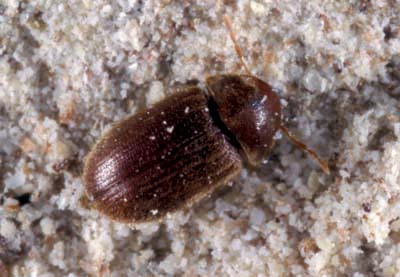
Adult drugstore beetle, Stegobium paniceum.
(Photographer: L.J. Buss, University of Florida)
Drugstore beetles are more abundant in warmer regions or in heated structures in more temperate climates. They are less abundant in the tropics than the cigarette beetle. This beetle feeds on drugs, flours, dry mixes, breads, cookies, chocolates and other sweets, and spices. It has a worldwide distribution.
Adult beetles are cylindrical, 2.25 to 3.5 mm long, and are a uniformly brown to reddish brown. They have longitudinal rows of fine hairs on the elytra (wing covers). Drugstore beetles are similar in appearance to the cigarette beetle; however, two physical characters can be used to tell the difference between them. The antennae of the cigarette beetle are serrated (like the teeth on a saw) while the antennae of the drugstore beetle are not and end in a 3-segmented club. The other difference is that the elytra (wing covers) of the drugstore beetle have rows of pits giving them a striated (lined) appearance while those of the cigarette beetle are smooth.
Female drugstore beetles lay up to 75 eggs in the food or substrate. Adult females live approximately 13 to 65 days. The larval period ranges from four to 20 weeks. The larvae are small, white grubs, but later instars are scarab-like. The entire life cycle is generally less than two months but can be as long as seven months. The duration of the life cycle is highly dependent on the temperature and food source.
Images
To save the Web-optimized images shown below to your hard drive:
|
Click to access Display and Print quality images. |
|
Click to access Display and Print quality images. |